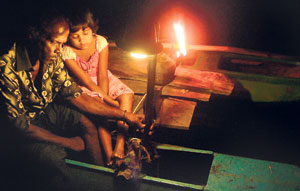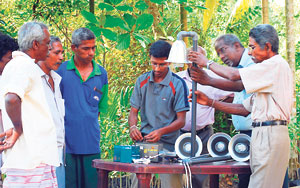Standing on a small wooden jetty on a cold night at the Madampa Lagoon dotted by the lights of the fishing canoes, I can see the fishermen busy checking their nets. A canoe moves toward us. Instead of the traditional kerosene lamps, the fisherman is using a somewhat high-tech lamp emitting a bright light that would assist him to collect the fish entangled in his nets.
Nelson - the old fisherman in the canoe who has been fishing for a living for decades is quite happy using this innovative solar-powered lamp. “Fishing is easier with this new light,” Nelson says turning the light towards me. The light can be twisted toward different directions while its hood helps to keep the beam concentrated. This mobility is handy compared to the old kerosene lamp which the fisherman had to balance in the small canoe.
 |
| Nelson and his grand-daughter with their new solar powered lamp and below fishermen are taught to operate the lamp |
 |
There were instances when the kerosene would spill contaminating the catch. Such accidents also pollute this important ecosystem. The adjoining Madu Ganga is a Ramsar Wetland of international importance. The kerosene lamps were also difficult to operate in rainy and windy days. “The smoke was difficult to our eyes and our nostrils would be black from the soot particles we were breathing in every night,” Nelson added that they frequently had respiratory related ailments.
The smoke-free new solar lamp is also an alternative renewable energy solution reducing carbon dioxide emission that contributes to global warming. The Nagenahiru Foundation who initiated this solar lamp project two years ago said a lagoon fishing vessel used more than one litre of kerosene per night for lighting. There are 375 night fishermen in Maduganga– Madampa Lake area which would amount to roughly 400 litres of kerosene being used per night.
According to the available statistics, burning of 1.2 litres of kerosene emits about 3.14 kg of carbon dioxide. So the total emissions of 375 fishing vessels in the area alone will produce 1256 kg of carbon dioxide emissions every night. So this fishing fleet would emit a minimum of 408 metric tonnes of carbon dioxide annually to the atmosphere.
The project that was started with only a few lamps has gained popularity very soon. “The new lighting system is good for our pocket too,” Jayalath, a younger fisherman said. The cost of kerosene monthly accounted for about 30% of the income of these poor fishermen.
The Nagenahiru Foundation under founder president Lal Emmanuel has already distributed 250 of these units among the fishing community in the Ambalangoda Madampa Lagoon. This unit is powered by a rechargeable 12 Volt 4-6 Ampere seal lead acid battery. The lanterns use CFL (Compact Fluorescent Lamps) lamps that consume low energy and provide an improved light lasting for about 30 hours. These affordable lanterns can be charged from the main electric grid or using solar panels, making the system cheaper than kerosene lanterns in the long term.
The Nagenahiru Foundation is targeting the inland fisheries community operating in lagoons, rivers and lakes. According to their estimates there are about 35,000 fishermen who engage in inland fisheries and this would be a cost-effective environmental-friendly solution. The Foundation which also does mangrove conservation and community work at Madampa lagoon won the International “One World Award” in 2008 for the solar lamp concept.
The lamp is the brainchild of young Sajeewa Emmanuel, Lal’s son. Sajeewa who has been experimenting with circuits since his schooldays got the idea of replacing the kerosene lamps used by the Madu-ganga Ja-kotu fisherman to catch prawn. Ja-kotu is made of interwoven bamboo panels consisting of two units of three interconnected chambers. The Ja-kotu system requires lighting seven kerosene lamps to attract prawns to the chambers.
It wasn’t easy to implement the solar lamp system for Ja-kotu. “There is a right intensity of light that prawns are attracted to and we had to experiment for months to fine tune the lamp,” said Sajeewa. He used an LED bulb system as prawns are attracted only to yellow or orange lighting. “Even the height of the lamp matters,” he said.
There are about 60 Ja–kotus at night in the Madu Ganga. A single lamp system could consume about 3.0 to 3.5 litres of kerosene every night and these could burn more than 180 to 210 litres of kerosene every month. During 325 nights per year ( approximate figure of how many nights worked per year ) they burn 58,500 to 60,250 litres of kerosene and emit more than 1836 metric tons of carbon dioxide to the atmosphere at the rate of 3.14 kg per 1.2 litre of kerosene oil burnt. In a bigger context it saves foreign exchange spent on importing kerosene.
The Nagenahiru Foundation has begun introducing this concept to other areas too. It is estimated that there are about 35,000 registered night fishermen engaged in night fishing in inland water bodies such as lagoons, estuaries and tanks and the Foundation aims to replace about 20,000 kerosene lanterns with the new CFL light system in the next five years.
The fishing communities in Lunugamwehera and Malala Lagoon are the next to benefit from this project.
NF: Awareness programmes for students and adults
The Nagenahiru Foundation (NF) won the national award offered by the Environmental Ministry for Environmental Education in 2009. Other than promoting solar lamps, they work on mangrove conservation and alternative livelihoods for communities and conduct education programmes at their centre located at the banks of Madampa lagoon.
Students from nearby schools are frequent visitors at the centre to learn about mangroves and wetland biodiversity. A raft was converted into a ‘Floating Classroom’ and the students get a chance to get close to the mangroves and study their special features like the breathing roots, adaptations of mangrove fruits etc closely.
The mangrove education programme conducted by the Nagenahiru centre is also open to adults. NF reaches adult villagers through the Grama Sevaka or Samurdi Agents. “The main aim is to emphasize the importance of mangroves,” said Bandula Jayanetti who is the Education Officer of Nagenahiru Education Centre. Mangroves play a very vital role in the sustainability of lagoon fishery and is also one of the best carbon trapping plant community that helps to remove Co2 from the atmosphere.
The Nagenahiru Centre at Madampa lagoon also has camping facilities for about 40 visitors who can get the opportunity to have a closer look at these mangroves and the lagoon biodiversity. Contact Nagenahiru Foundation for more information on nagenahiru@sltnet.lk |
